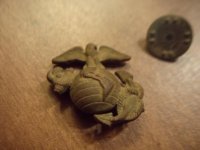Recovering Relics
Full Member
- Jan 12, 2010
- 202
- 2
- 🏆 Honorable Mentions:
- 1
- Detector(s) used
- Whites MXT, Garret Pro Pointer, Lesche Digger
- Primary Interest:
- All Treasure Hunting
Another great find in my yard. In the summer I found a USMC Button with gold guild on it. Does anyone have any info on this find. Age? Rarity? etc.
Attachments
Upvote
0








